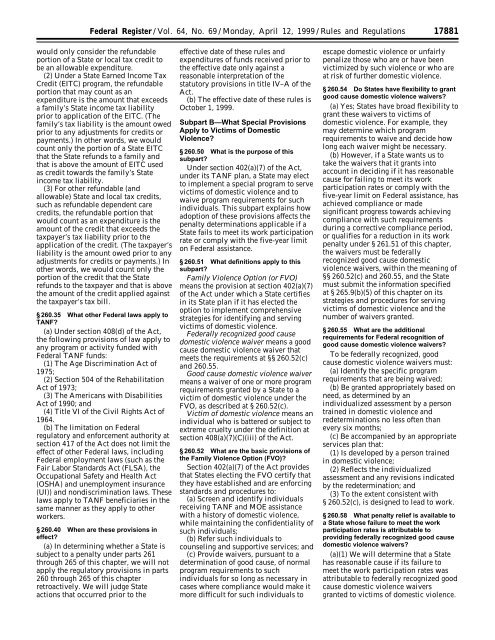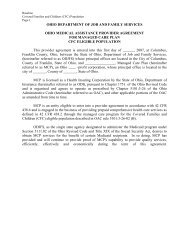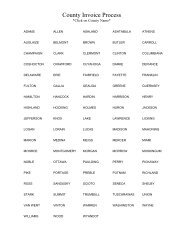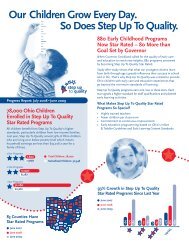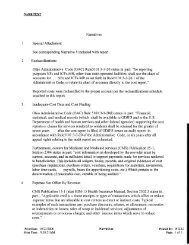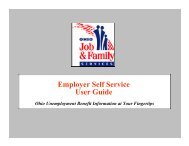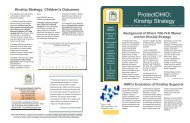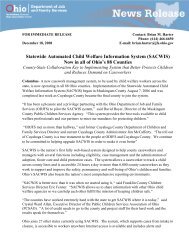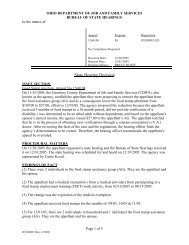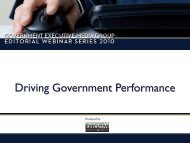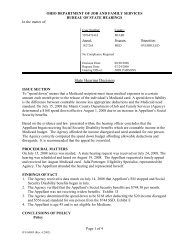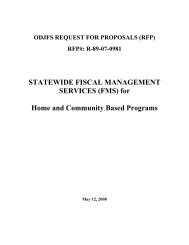Final TANF Rule as published in the Federal Register 4/12/1999
Final TANF Rule as published in the Federal Register 4/12/1999
Final TANF Rule as published in the Federal Register 4/12/1999
You also want an ePaper? Increase the reach of your titles
YUMPU automatically turns print PDFs into web optimized ePapers that Google loves.
<strong>Federal</strong> <strong>Register</strong> / Vol. 64, No. 69 / Monday, April <strong>12</strong>, <strong>1999</strong> / <strong>Rule</strong>s and Regulations<br />
would only consider <strong>the</strong> refundable<br />
portion of a State or local tax credit to<br />
be an allowable expenditure.<br />
(2) Under a State Earned Income Tax<br />
Credit (EITC) program, <strong>the</strong> refundable<br />
portion that may count <strong>as</strong> an<br />
expenditure is <strong>the</strong> amount that exceeds<br />
a family’s State <strong>in</strong>come tax liability<br />
prior to application of <strong>the</strong> EITC. (The<br />
family’s tax liability is <strong>the</strong> amount owed<br />
prior to any adjustments for credits or<br />
payments.) In o<strong>the</strong>r words, we would<br />
count only <strong>the</strong> portion of a State EITC<br />
that <strong>the</strong> State refunds to a family and<br />
that is above <strong>the</strong> amount of EITC used<br />
<strong>as</strong> credit towards <strong>the</strong> family’s State<br />
<strong>in</strong>come tax liability.<br />
(3) For o<strong>the</strong>r refundable (and<br />
allowable) State and local tax credits,<br />
such <strong>as</strong> refundable dependent care<br />
credits, <strong>the</strong> refundable portion that<br />
would count <strong>as</strong> an expenditure is <strong>the</strong><br />
amount of <strong>the</strong> credit that exceeds <strong>the</strong><br />
taxpayer’s tax liability prior to <strong>the</strong><br />
application of <strong>the</strong> credit. (The taxpayer’s<br />
liability is <strong>the</strong> amount owed prior to any<br />
adjustments for credits or payments.) In<br />
o<strong>the</strong>r words, we would count only <strong>the</strong><br />
portion of <strong>the</strong> credit that <strong>the</strong> State<br />
refunds to <strong>the</strong> taxpayer and that is above<br />
<strong>the</strong> amount of <strong>the</strong> credit applied aga<strong>in</strong>st<br />
<strong>the</strong> taxpayer’s tax bill.<br />
§ 260.35 What o<strong>the</strong>r <strong>Federal</strong> laws apply to<br />
<strong>TANF</strong>?<br />
(a) Under section 408(d) of <strong>the</strong> Act,<br />
<strong>the</strong> follow<strong>in</strong>g provisions of law apply to<br />
any program or activity funded with<br />
<strong>Federal</strong> <strong>TANF</strong> funds:<br />
(1) The Age Discrim<strong>in</strong>ation Act of<br />
1975;<br />
(2) Section 504 of <strong>the</strong> Rehabilitation<br />
Act of 1973;<br />
(3) The Americans with Disabilities<br />
Act of 1990; and<br />
(4) Title VI of <strong>the</strong> Civil Rights Act of<br />
1964.<br />
(b) The limitation on <strong>Federal</strong><br />
regulatory and enforcement authority at<br />
section 417 of <strong>the</strong> Act does not limit <strong>the</strong><br />
effect of o<strong>the</strong>r <strong>Federal</strong> laws, <strong>in</strong>clud<strong>in</strong>g<br />
<strong>Federal</strong> employment laws (such <strong>as</strong> <strong>the</strong><br />
Fair Labor Standards Act (FLSA), <strong>the</strong><br />
Occupational Safety and Health Act<br />
(OSHA) and unemployment <strong>in</strong>surance<br />
(UI)) and nondiscrim<strong>in</strong>ation laws. These<br />
laws apply to <strong>TANF</strong> beneficiaries <strong>in</strong> <strong>the</strong><br />
same manner <strong>as</strong> <strong>the</strong>y apply to o<strong>the</strong>r<br />
workers.<br />
§ 260.40 When are <strong>the</strong>se provisions <strong>in</strong><br />
effect?<br />
(a) In determ<strong>in</strong><strong>in</strong>g whe<strong>the</strong>r a State is<br />
subject to a penalty under parts 261<br />
through 265 of this chapter, we will not<br />
apply <strong>the</strong> regulatory provisions <strong>in</strong> parts<br />
260 through 265 of this chapter<br />
retroactively. We will judge State<br />
actions that occurred prior to <strong>the</strong><br />
effective date of <strong>the</strong>se rules and<br />
expenditures of funds received prior to<br />
<strong>the</strong> effective date only aga<strong>in</strong>st a<br />
re<strong>as</strong>onable <strong>in</strong>terpretation of <strong>the</strong><br />
statutory provisions <strong>in</strong> title IV–A of <strong>the</strong><br />
Act.<br />
(b) The effective date of <strong>the</strong>se rules is<br />
October 1, <strong>1999</strong>.<br />
Subpart B—What Special Provisions<br />
Apply to Victims of Domestic<br />
Violence?<br />
§ 260.50 What is <strong>the</strong> purpose of this<br />
subpart?<br />
Under section 402(a)(7) of <strong>the</strong> Act,<br />
under its <strong>TANF</strong> plan, a State may elect<br />
to implement a special program to serve<br />
victims of domestic violence and to<br />
waive program requirements for such<br />
<strong>in</strong>dividuals. This subpart expla<strong>in</strong>s how<br />
adoption of <strong>the</strong>se provisions affects <strong>the</strong><br />
penalty determ<strong>in</strong>ations applicable if a<br />
State fails to meet its work participation<br />
rate or comply with <strong>the</strong> five-year limit<br />
on <strong>Federal</strong> <strong>as</strong>sistance.<br />
§ 260.51 What def<strong>in</strong>itions apply to this<br />
subpart?<br />
Family Violence Option (or FVO)<br />
means <strong>the</strong> provision at section 402(a)(7)<br />
of <strong>the</strong> Act under which a State certifies<br />
<strong>in</strong> its State plan if it h<strong>as</strong> elected <strong>the</strong><br />
option to implement comprehensive<br />
strategies for identify<strong>in</strong>g and serv<strong>in</strong>g<br />
victims of domestic violence.<br />
<strong>Federal</strong>ly recognized good cause<br />
domestic violence waiver means a good<br />
cause domestic violence waiver that<br />
meets <strong>the</strong> requirements at §§ 260.52(c)<br />
and 260.55.<br />
Good cause domestic violence waiver<br />
means a waiver of one or more program<br />
requirements granted by a State to a<br />
victim of domestic violence under <strong>the</strong><br />
FVO, <strong>as</strong> described at § 260.52(c).<br />
Victim of domestic violence means an<br />
<strong>in</strong>dividual who is battered or subject to<br />
extreme cruelty under <strong>the</strong> def<strong>in</strong>ition at<br />
section 408(a)(7)(C)(iii) of <strong>the</strong> Act.<br />
§ 260.52 What are <strong>the</strong> b<strong>as</strong>ic provisions of<br />
<strong>the</strong> Family Violence Option (FVO)?<br />
Section 402(a)(7) of <strong>the</strong> Act provides<br />
that States elect<strong>in</strong>g <strong>the</strong> FVO certify that<br />
<strong>the</strong>y have established and are enforc<strong>in</strong>g<br />
standards and procedures to:<br />
(a) Screen and identify <strong>in</strong>dividuals<br />
receiv<strong>in</strong>g <strong>TANF</strong> and MOE <strong>as</strong>sistance<br />
with a history of domestic violence,<br />
while ma<strong>in</strong>ta<strong>in</strong><strong>in</strong>g <strong>the</strong> confidentiality of<br />
such <strong>in</strong>dividuals;<br />
(b) Refer such <strong>in</strong>dividuals to<br />
counsel<strong>in</strong>g and supportive services; and<br />
(c) Provide waivers, pursuant to a<br />
determ<strong>in</strong>ation of good cause, of normal<br />
program requirements to such<br />
<strong>in</strong>dividuals for so long <strong>as</strong> necessary <strong>in</strong><br />
c<strong>as</strong>es where compliance would make it<br />
more difficult for such <strong>in</strong>dividuals to<br />
17881<br />
escape domestic violence or unfairly<br />
penalize those who are or have been<br />
victimized by such violence or who are<br />
at risk of fur<strong>the</strong>r domestic violence.<br />
§ 260.54 Do States have flexibility to grant<br />
good cause domestic violence waivers?<br />
(a) Yes; States have broad flexibility to<br />
grant <strong>the</strong>se waivers to victims of<br />
domestic violence. For example, <strong>the</strong>y<br />
may determ<strong>in</strong>e which program<br />
requirements to waive and decide how<br />
long each waiver might be necessary.<br />
(b) However, if a State wants us to<br />
take <strong>the</strong> waivers that it grants <strong>in</strong>to<br />
account <strong>in</strong> decid<strong>in</strong>g if it h<strong>as</strong> re<strong>as</strong>onable<br />
cause for fail<strong>in</strong>g to meet its work<br />
participation rates or comply with <strong>the</strong><br />
five-year limit on <strong>Federal</strong> <strong>as</strong>sistance, h<strong>as</strong><br />
achieved compliance or made<br />
significant progress towards achiev<strong>in</strong>g<br />
compliance with such requirements<br />
dur<strong>in</strong>g a corrective compliance period,<br />
or qualifies for a reduction <strong>in</strong> its work<br />
penalty under § 261.51 of this chapter,<br />
<strong>the</strong> waivers must be federally<br />
recognized good cause domestic<br />
violence waivers, with<strong>in</strong> <strong>the</strong> mean<strong>in</strong>g of<br />
§§ 260.52(c) and 260.55, and <strong>the</strong> State<br />
must submit <strong>the</strong> <strong>in</strong>formation specified<br />
at § 265.9(b)(5) of this chapter on its<br />
strategies and procedures for serv<strong>in</strong>g<br />
victims of domestic violence and <strong>the</strong><br />
number of waivers granted.<br />
§ 260.55 What are <strong>the</strong> additional<br />
requirements for <strong>Federal</strong> recognition of<br />
good cause domestic violence waivers?<br />
To be federally recognized, good<br />
cause domestic violence waivers must:<br />
(a) Identify <strong>the</strong> specific program<br />
requirements that are be<strong>in</strong>g waived;<br />
(b) Be granted appropriately b<strong>as</strong>ed on<br />
need, <strong>as</strong> determ<strong>in</strong>ed by an<br />
<strong>in</strong>dividualized <strong>as</strong>sessment by a person<br />
tra<strong>in</strong>ed <strong>in</strong> domestic violence and<br />
redeterm<strong>in</strong>ations no less often than<br />
every six months;<br />
(c) Be accompanied by an appropriate<br />
services plan that:<br />
(1) Is developed by a person tra<strong>in</strong>ed<br />
<strong>in</strong> domestic violence;<br />
(2) Reflects <strong>the</strong> <strong>in</strong>dividualized<br />
<strong>as</strong>sessment and any revisions <strong>in</strong>dicated<br />
by <strong>the</strong> redeterm<strong>in</strong>ation; and<br />
(3) To <strong>the</strong> extent consistent with<br />
§ 260.52(c), is designed to lead to work.<br />
§ 260.58 What penalty relief is available to<br />
a State whose failure to meet <strong>the</strong> work<br />
participation rates is attributable to<br />
provid<strong>in</strong>g federally recognized good cause<br />
domestic violence waivers?<br />
(a)(1) We will determ<strong>in</strong>e that a State<br />
h<strong>as</strong> re<strong>as</strong>onable cause if its failure to<br />
meet <strong>the</strong> work participation rates w<strong>as</strong><br />
attributable to federally recognized good<br />
cause domestic violence waivers<br />
granted to victims of domestic violence.


